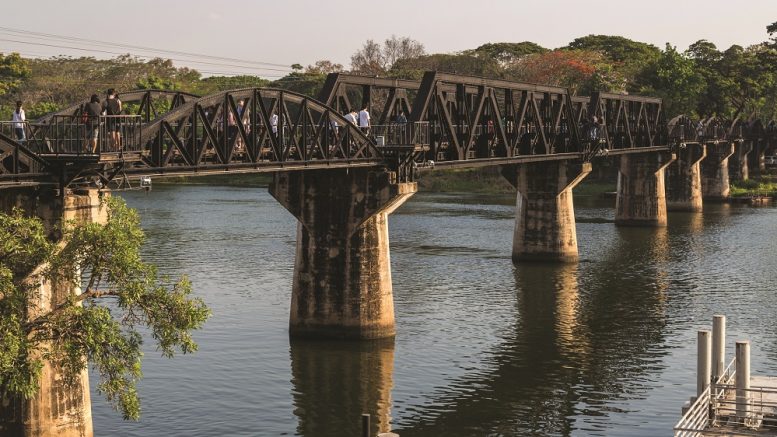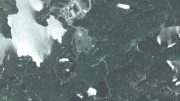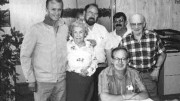After spending 17 years with Newmont Mining as a senior exploration geologist, and being transferred twice in the same year (1997), I decided it was time to strike out and do something new.
As fate would have it, later that year I landed a most interesting job with a privately funded, start-up mining and energy exploration company.
The company was owned by Mr. Mohamed Al Fayed, a wealthy Egyptian business man who resided just outside of London. Mr. Fayed — or the “Chairman,” as we called him — had lost his son in a car accident earlier that year with Princess Diana.
The Chairman owned a network of more than 30 businesses covering a wide range of enterprises. These included things like the Harrods Department Store in London, the Ritz Hotel in Paris, Fulham Football team, and all manner of enterprises.
He had previously been a director of Lonrho (London-Rhodesia Mining), and had some familiarity with mining and exploration. He had also done business in the Persian Gulf.
The new company was named Harrods Natural Resources Inc. and the business was built around a unique strategy for the time. The Chairman had observed rapid advances in satellite technology, specifically remote sensing, and noted the applications for mineral and oil exploration.
He hired away a team of top-notch geologists and remote sensing specialists from Chevron Resources and they established an office just outside of San Francisco in a lovely enclave known as Walnut Creek.
I was brought in to optimize and integrate the remote sensing technology with exploration opportunities and lead the exploration program.
The Chairman had a vast network of connections around the world, and my first two years were filled with country and property-scale evaluations leveraging these contacts.
We began with a large program in Mongolia, which was just opening up and ideally suited for remote sensing. We then worked our way through Southeast Asia, bits of Africa and down into Latin America, culminating in a sizeable program in Peru.
In early 2000, I moved to London and based my office next to the Harrods store.
Unusual situation
On a Monday in April I had just returned to London from a business trip when I received three phone messages about a very unusual situation in Thailand. I was instructed to stop by the Chairman’s office immediately for a briefing but be ready to travel as soon as possible.
I learned that we had been contacted by one of the Chairman’s friends from Thailand, and that there were stories in the news about a Thai Senator searching for a lost treasure. He was from Kanchanaburi state, near the Burmese border, and had heard a rumour that had been circulating for many years.
As background, towards the end of World War II, the Japanese military had built a railroad that crossed Thailand and connected to Burma (Myanmar). As the Japanese advanced, they had collected hoards of treasures and gold. As things began to deteriorate, the retreating army needed a place to hide their spoils. These were the same soldiers that supervised the building of the “Railroad of Death,” which included the bridge over the River Kwai (made famous in the movie with the same name). More than 100,000 people had reportedly died building the railroad, many were prisoners of war taken by the Japanese — including many U.S., Australian and British soldiers.
(My father had served in the Pacific Theatre and one of my earliest memories was watching that movie in a drive-in theatre.)
The Thai Senator reported he had evidence that 2,500 tonnes gold (80 million oz.) and more than US$100 billion in U.S. savings bonds had been found in a local cave, named the Leija Cave. The site was famous, and located within a national park.
Legend had it that the Japanese military had built a railroad spur from the main line into the cave and later drove a locomotive and bogey car full of gold into the cave, before blowing the entrance shut.
The Senator said there were indications the cave had not collapsed far past the portal, and he was petitioning the national government to excavate and reopen the cave entrance.
Thailand’s Prime Minister became engaged by the story and was on record supporting the Senator’s story. Thailand was suffering a major economic crisis after a real estate collapse and devaluation of the national currency, and the Prime Minister said that the treasure could be used to wipe out the national debt.
Friends
The PM was a personal friend of the Chairman and familiar with our remote sensing technology. Furthermore, he was quoted in the newspapers saying that he had “friends” in San Francisco with a satellite that could see deep below the surface of the earth, and he had contacted them to help explore the collapsed cave.
As is the case with new technology, particularly satellite imagery, the details and capabilities of the tool are often misunderstood.
The PM’s office had contacted us to help them with the search. He wanted us to look beneath the ground and find the train, and, more importantly, the treasure.
At first, I was convinced that this was a hoax. I told the Chairman, my boss, that there was definitely no treasure and he told me to “give the PM what he needed.”
So it looked as though I was heading to Thailand.
I recommended we meet with the PM to explain the problem with his ideas and explain the realities of satellite imagery.
In the meantime we prepared the best available imagery of the area, to lend credence to the PM’s public statements.
By Thursday that week, the Thai police had arrested five men trying to sell fake U.S. savings bonds, and the PM was being mocked in the press.
I flew to Bangkok that Saturday with two colleagues, and by the Monday morning our Landsat images arrived at my hotel.
Upon close examination of the imagery and accompanying maps, I confirmed that the cave theory was at least plausible due to the cave’s location within a kilometer of the main railroad line to Myanmar along the River Kwai.
That night our team met with the PM, and I attempted to explain the situation and why the satellite data could not penetrate beneath the earth’s surface.
The monk and the cobra
It was clear to me that the PM was infatuated with the legend. I’m no expert on religion, but Buddhism seems like it contains many lessons that are taught with colourful and imaginative stories. This one seemed to fit the bill.
The PM told us about the Senator’s story. The Senator said that he had spoken to an elderly Buddhist monk who had entered the cave by crawling through a small opening. Once inside, he met a large cobra guarding another small opening just past the entrance.
The monk explained to the cobra that he wanted to go in and look around, and the cobra let him pass. Deeper inside, the monk said he found a locomotive with an attached cart loaded with gold, though he made no mention of the savings bonds. He added that the train was surrounded by the skeletal remains of soldiers slumped on the ground after committing hara-kiri — their swords still lodged between their ribs.
This was a fantastic story, and difficult to ignore. But I tried to stay on mission. We were here to help him out.
Addressing the PM’s desire to evaluate the cave from the surface, I explained that we could figure out where the cave went and determine if there was anything resembling a train inside, but that it would be a very elaborate operation.
Without getting into the finer details, I suggested we could start with some simple geophysical surveys that could determine if there was a conductive set of rails or a large metallic train buried in a mountain.
But to do so, we would have to clear cut lines through the jungle of the national park. Not a major problem for us, but it would certainly attract a lot of attention and impact the jungle.
At the same time that I was explaining this strategy, I was digesting the situation: we had the Prime Minister of the country trying to solve the nation’s financial crisis by dreaming about a train lode of gold left by retreating soldiers. Then I had my boss, who had been somewhat misquoted about the power of satellite technology.
Nonetheless, the PM was expecting a solution. We needed a plan that would protect the PM’s reputation, as well as the Chairman’s.
I felt jet lagged. I tried to remove all the elaborate storytelling and get down to something resembling logic.
Then it hit me
The most obvious thing to do was to enter the cave and see what was there. I pitched this idea to the PM without consulting my colleagues.
Then I mentioned to him that there were many professional cave explorers, and people who like to do this sort of thing for fun may be better suited for the task.
I suggested that because this was such an exciting story, he should contact a group like the National Geographic Society, as they love these types of adventure stories.
It struck me as a safe political move.
Everyone seemed to like this idea, and our meeting was soon over and our team returned to the hotel.
The next day the Prime Minister left the country for a visit to Malaysia and Vietnam.
On the Wednesday, I delivered a summary memo containing our observations and recommendations to the PM’s office, and he returned to Bangkok by the Thursday evening.
The next morning, I awoke early at 5:30 a.m. and turned on the television only to hear a CNN presenter state: “The Thailand Prime Minister has asked the National Geographic Society to help him evaluate a network of caves that may contain World War II treasures, left behind by retreating Japanese troops…”
This was also written in the headlines that rolled across the bottom of the television.
Later in the day I saw similar stories in all the national papers.
I returned to London that evening with my colleagues.
As for the cave, nothing was ever heard about it again. The story dried up and blew away, and the PM went on to bigger problems.
—Based in Vancouver, Keith Laskowski is a geologist specializing in exploration and resource evaluation. He is currently vice-president of technical services at Sandstorm Gold.




Very captivating story. Kept me engaged to the very end. Would have liked to hear that 80m oz of gold was discovered but I guess that’s what fairy tales are for! Thanks for sharing Keith. You should write more often!
Thanks
So you’re telling us that Sandstrom is financing a cave exploration program and is getting a royalty of 15% of all the gold found?
Thanks, only if it has a reasonable rate of return and risk.
I really loved the story about the cobra! and just interesting how the story ends with the PM moving on to “bigger things” like forgetting about the national monetary problem. Just another hidden and lost treasure story and a bullshit legend! Why do you need cave explorers as trains don’t do well going up or downgrades and around sharp curves! Any seasoned spelunker will tell you all caves are irregular in form! If the Japanese built a railway line into a cave, the locomotive would be relatively close to the entrance. The story is more akin to a Tom Clancy novel.
“There are strange things done, in the midnight sun, by the men who moil for gold” (R.Service)
Fascinating story, reminds me of the recurring tales of Nazi gold or even further back to Napoleon’s retreating army. For context compare art objects looted, which generally are distributed far and wide (or hoarded in a museum)